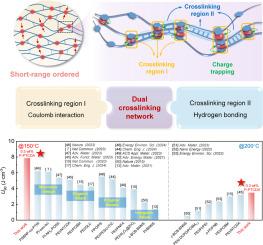在全有机芳纶复合薄膜中定制双交联网络,用于优越的高温电容储能
IF 20.2
1区 材料科学
Q1 CHEMISTRY, PHYSICAL
引用次数: 0
摘要
聚合物薄膜电容器在先进电力系统的储能领域起着不可替代的作用。然而,在高温应用中,通常会观察到泄漏电流的大幅激增,从而导致不希望的能量损失。在这里,我们提出了由聚(间苯二苯酰胺)(PMIA)和苝-3,4,9,10-四羧酸二酐(PTCDA)组成的全有机复合薄膜。PMIA和PTCDA之间强大的库仑引力使相邻的PMIA链更紧密,从而促进了本然氢键的形成。因此,出现了双交联网络,将远程无序的PMIA链裁剪成短程有序状态,即使在高温条件下也能保持稳定。因此,提高了热稳定性、存储模量和击穿强度,同时有效地抑制了介电损耗。此外,PTCDA的高电子亲和力抑制了分子间π离域电子传递,通过增加深阱密度和深度捕获载流子。通过抑制高温泄漏电流,PMIA-PTCDA薄膜(优化温度为0.3 wt%)在150℃和200℃下的放电能量密度(Ud)分别为7.86 J·cm-3和3.37 J·cm-3,效率(η)超过90%。在η>;80%和150°C时,最大Ud为11.79 J·cm-3。此外,PTCDA的超低成本为大规模生产和潜在的商业化提供了可能性。本文章由计算机程序翻译,如有差异,请以英文原文为准。


Tailoring a dual crosslinking network in all-organic aramid composite film for superior high-temperature capacitive energy storage
Polymer-based film capacitors play an irreplaceable part in the energy storage domain of advanced electrical systems. However, in high-temperature applications, a substantial surge in leakage current is commonly observed, causing undesired energy loss. Here, we present all-organic composite films consisting of poly(m-phenylene isophthalamide) (PMIA) and perylene-3,4,9,10-tetracarboxylic dianhydride (PTCDA). The strong Coulomb attraction between PMIA and PTCDA draws adjacent PMIA chains closer, which in turn enhances the formation of intrinsic hydrogen bonds. Therefore, a dual crosslinking network emerges, tailoring the long-range disordered PMIA chains into a short-range ordered state, which is also proved to maintain stable even under high-temperature conditions. Consequently, the thermal stability, storage modulus, and breakdown strength are enhanced, while the dielectric loss is effectively suppressed. Moreover, the high electron affinity of PTCDA inhibits intermolecular π-delocalized electron transport, entrapping carries by increasing deep trap density and depth. By suppressing high-temperature leakage current, the PMIA-PTCDA film (optimized at 0.3 wt%) achieves a discharge energy density (Ud) of 7.86 J cm-3 at 150 °C and 3.37 J cm-3 at 200 °C, with an efficiency (η) exceeding 90 %. A record maximum Ud of 11.79 J cm-3 is attained at η > 80 % and 150 °C. Furthermore, the ultra-low cost of PTCDA offers possibilities for large-scale production and potential commercialization.
求助全文
通过发布文献求助,成功后即可免费获取论文全文。
去求助
来源期刊

Energy Storage Materials
Materials Science-General Materials Science
CiteScore
33.00
自引率
5.90%
发文量
652
审稿时长
27 days
期刊介绍:
Energy Storage Materials is a global interdisciplinary journal dedicated to sharing scientific and technological advancements in materials and devices for advanced energy storage and related energy conversion, such as in metal-O2 batteries. The journal features comprehensive research articles, including full papers and short communications, as well as authoritative feature articles and reviews by leading experts in the field.
Energy Storage Materials covers a wide range of topics, including the synthesis, fabrication, structure, properties, performance, and technological applications of energy storage materials. Additionally, the journal explores strategies, policies, and developments in the field of energy storage materials and devices for sustainable energy.
Published papers are selected based on their scientific and technological significance, their ability to provide valuable new knowledge, and their relevance to the international research community.
 求助内容:
求助内容: 应助结果提醒方式:
应助结果提醒方式:


